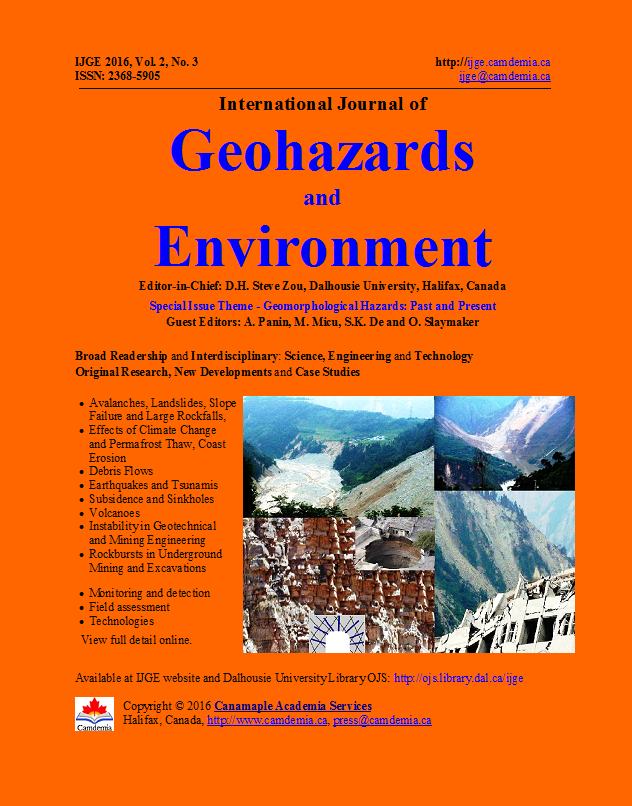Debris Flows of the Tunkinsky Goltsy Mountains (Tunkinsky District, Republic of Buryatia in Eastern Siberia)
DOI:
https://doi.org/10.15273/ijge.2016.03.016Keywords:
debris flow, soil avalanchings, kars (cirques), radiocarbon age, Holocene, Tunkinsky Goltsy Mountains, Arshan villageAbstract
On the night of June 28, 2014, near the village of Arshan in Tunkinsky district, Republic of Buryatia in eastern Siberia, two types of debris flows were formed as a result of intense storm precipitation: 1) debris floods along the river Kyngarga; 2) debris flows along the valleys originating from the cirques of the southern slope of the Tunkinsky Goltsy range, which went in the south-west direction towards the village. A year later, July 14, 2015, in the village of Arshan a debris flood occurred in the river Kyngarga. During the Holocene debris flows have occurred repeatedly, traces of which are seen in the sections of loose deposits. Their age was defined with the help of radiocarbon analysis of buried soil horizons. A historical analysis of debris flow activity on the territory for more than a century was made using published scientific works. Natural factors for the formation of debris flow situation were considered (synoptic and climatic conditions, hydrology, geology and landscape structure were evaluated). Reasons for the most recent debris flows were defined. A detailed analysis was given of the valleys of a number of rivers where results of debris flows were the most destructive. As a result of the debris flow along the river Kharimta, realignment of the river network took place. Consequences of debris flows for the natural environment and infrastructure of the village of Arshan were evaluated. It is considered that the partial destruction of the village of Arshan is a distinct possibility in the near future due to debris flows from cirque #1.Downloads
Issue
Section
License
Copyright, Terms and Conditions
The International Journal of Geohazards and Environment (the Journal) is published by Canamaple Academia Services (the Publisher) online with open access, under a Creative Commons Attribution-Noncommercial license (CC-BY-NC) (http://creativecommons.org/licenses/by-nc/4.0/). Authors (the Authors) submitting papers (the Work) for publication in the Journal automatically agree to the following terms and conditions.
1. Under the license (CC-BY-NC), Authors give permission for others to share and reuse the Work, as long as the original source and author(s) are properly cited (i.e. a complete bibliographic citation and link to the Journal website) and the material is not used for commercial purposes. Any sharing or reuse must however indicate the original CC-BY-NC license terms of the work.
2. Authors transfer and assign to the Publisher all copyright in and to the Work. However Authors retain all proprietary rights except the copyright, related to the Work and also retain the rights a) to use, reproduce, distribute, and publicly display the Work in any medium in connection with the Authors‘ academic and professional activities, such as teaching, presentations and lectures, b) to create derivative works from the Work and to make full use of the Work in future research and publications, c) to authorize others to make any non-commercial use of the Work, d) to make both the pre-published and final-published versions available online in institutional and/or disciplinary repositories or on their own websites with a citation and link to the original paper published in the Journal.
3. Authors warrant that the Work is their original work, it is not copied from anywhere or anyone else, they are totally responsible for the authenticity, originality, validity and accuracy, and the facts and views are their own, that the Work contains no matter which is defamatory or infringes any literary or proprietary rights, intellectual property rights, or any rights of privacy, and that the Work has not been simultaneously submitted to any other journals or publishers. Authors further agree that their manuscripts whether accepted or rejected will not be returned and the rejected manuscripts will be disposed at the journal editor's discretion.
Disclaimer: The Publisher, the Journal and the editors accept no responsibility for statements or opinions expressed by authors. Use of information and materials in the Journal is the sole responsibility of users.


